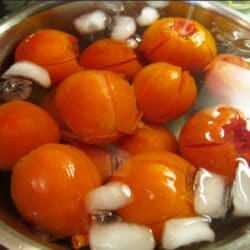How to Blanch Vegetables (How-To)
Pin RecipeWhen done correctly, blanching preserves color, flavor, texture, and nutritional content. It softens the exterior of the food, maintains crispness to the interior, and imparts a little sweetness.
Equipments:
- Large bowl
- Slotted spoon
- Large pot
Ingredients:
- vegetables or fruits
- water
- salt
- Ice
Watch the Video:
Instructions:
- Have ready a large bowl of ice water (known as an ice bath), a slotted spoon, and a plate lined with a cloth or paper towel.
- In a large pot, pour 1 or 2 quarts of water and bring it to a boil. When the water is boiling, carefully drop the fruits or veggies in, immersing it.
- You can prepare the vegetables or fruits by cutting them just before the blanching process to prevent oxidation. Cut them into uniform pieces to ensure even cooking.
- Add 1 or 2 tablespoon of salt (add 1 tablespoon per 1 quart) to the boiling water. Adding salt maintains the color and helps improve the flavor of your veggies (this is optional).
- Add veggies in small batches, this way the water continues to boil. If blanching more than one type of vegetable, blanch each one separately and blanch lighter colored ones first, as darker colored ones will tinge the water and subsequent vegetables.
- Test for doneness after 30 seconds by removing one piece, dip in the water, and taste. Keep tasting every 30-60 seconds until the vegetables are cooked to your liking. Most vegetables take between 2-3 minutes.
- Once they are done, quickly remove them from the boiling water with a slotted spoon and plunge them into the ice bath to stop the cooking process. (This is called "shocking.")
- When the vegetables are completely cool, remove them from the ice bath and drain them on the towel-lined plate.
Notes:
- Although you might be tempted to forgo the ice water bath treatment, don't. It is critical because it prevents further cooking, and maintains the food's color and texture.
- The majority of recipes will tell you to salt the boiling water. Salting adds to the veggies' flavor, it also lessens the loss of the foods' salts and sugars that would otherwise leach into the water.
- The quantity of salt you should add is debatable. I normally add 2 tablespoon of salt for every quart of water. Some chefs say to salt the water as you would if you were cooking pasta. Others recommend adding more salt so that the water tastes similar to brine. The salt adds flavor to the veggies while raising the boiling point of water hence, cooking them faster.
- Once the food has been added to the boiling water, it must be brought back to the boil within a minute. When it takes longer to return to the boil, it is an indicator that either there is too much food for the quantity of water, or that the pan is overlarge.
- If you are blanching to remove the food's skin easier, cut a shallow x into the bottom of the fruit to start the skinning off.
Please note that all nutrition information are just estimates. Values will vary among brands, so we encourage you to calculate these on your own for most accurate results.
Did you make this?I would love seeing what you've made! Tag me on Instagram @theforkbitedotcom or leave me a comment or rating below.
